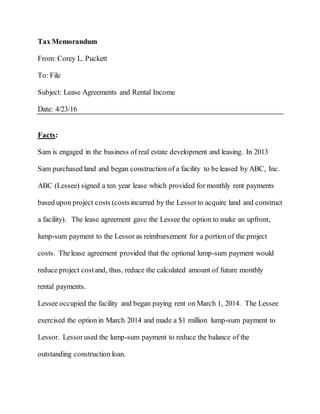
Tax Memorandum Lease Agreements
- 1. Tax Memorandum From: Corey L. Puckett To: File Subject: Lease Agreements and Rental Income Date: 4/23/16 Facts: Sam is engaged in the business of real estate development and leasing. In 2013 Sam purchased land and began construction of a facility to be leased by ABC, Inc. ABC (Lessee) signed a ten year lease which provided for monthly rent payments based upon project costs (costsincurred by the Lessorto acquire land and construct a facility). The lease agreement gave the Lessee the option to make an upfront, lump-sum payment to the Lessor as reimbursement for a portion of the project costs. Thelease agreement provided that the optional lump-sum payment would reduce project costand, thus, reduce the calculated amount of future monthly rental payments. Lessee occupied the facility and began paying rent on March 1, 2014. The Lessee exercised the option in March 2014 and made a $1 million lump-sum payment to Lessor. Lessorused the lump-sum payment to reduce the balance of the outstanding construction loan.
- 2. Lessee issued to Lessora Form 1099-MISC which reported as rents for 2014 the sum of $150,000 (sum of monthly rent payments for March - December of 2014) plus the $1 million lump-sum payment for total rent of $1,150,000. In February 2015, Lessorasked Lessee to file an amended Form 1099-MISC and to report rent payments of $150,000 for 2014 and a $1 million lump-sum reimbursement of "project costs." TheLessee issued the amended 1099-MISC as requested by the Lessor. Issue(s): Does Sam have to report the lump sum of $1,000,000 as income in the year of receipt? Conclusion: Sam has to report all $1,000,000 as income in the year of receipt. The structure of the lease agreement makes the $1,000,000 a prepaid rent expense for the Lessee and $1,000,000 prepaid rental income for Sam. Sam should have structured the lease agreement differently so that the $1,000,000 wouldn’t be prepaid rental income. One way he could have done this is: 1. Sam could have asked ABC to pay $1,000,000 for the project costs, separating the payment completely from the lease agreement and rent. Now, there isn’t a quid-pro-quo substancewithin the agreement, which the IRS would stand by as prepaid rental income. But instead, ABC paid $1,000,000
- 3. directly to the contractor performing the project, and the lease agreement would have rent payments with no ties to a reduction in rent expense. Findings: Current Internal Revenue Code,SEC. 467.CERTAIN PAYMENTS FOR THE USE OF PROPERTYOR SERVICES 467(a)AccrualMethod on Present Value Basis.— In the case of the lessor or lessee under any section 467 rental agreement, there shall be taken into account for purposes of this title for any taxable year the sum of— 467(a)(1) the amount of the rent which accrues during such taxable year as determined under subsection (b) 467(b)(1)Allocation follows agreement.— Except as provided in paragraph (2), the determination of the amount of the rent under any section 467 rental agreement which accrues during any taxable year shall be made— 467(b)(1)(A) by allocating rents in accordancewith the agreement, and 467(b)(1)(B)
- 4. by taking into account any rent to be paid after the close of the period in an amount determined under regulations which shall be based on present value concepts. 467(b)(2) Constantrental accrualin case of certain tax avoidancetransactions, etc.— In the case of any section 467 rental agreement to which this paragraph applies, the portion of the rent which accrues during any taxable year shall be that portion of the constant rental amount with respect to such agreement which is allocable to such taxable year. 467(e)(1)Constantrentalamount.— The term “constantrental amount” means, with respectto any section 467 rental agreement, the amount which, if paid as of the close of each lease period under the agreement, would result in an aggregate present value equal to the present value of the aggregate payments required under the agreement. 467(f)ComparableRulesWhere Agreement for Decreasing Payments.— Under regulations prescribed by the Secretary, rules comparable to the rules of this section shall also apply in the case of any agreement where the amount paid under the agreement for the use of property decreases during the term of the agreement.
- 5. Tax Court Regulars(Current), Michael H. Stough and BarbaraM. Stough v. Commissioner., U.S. TaxCourt, CCH Dec. 60,317, 144 TC 16, (Jun. 2, 2015) Lessors who entered into a 10-year lease agreement were obligated to treat a lump- sum payment from the lessees as reportable rental income for the year of receipt and were not allowed to allocate the payment proportionately over the life of the lease under CodeSec. 467. Because the lease only stated when rent was payable and did not provide a specific allocation of fixed rent, the amount of fixed rent allocated to a rental period was the amount of fixed rent payable during that rental period. Therefore, the lessors were required to report the entire lump-sum payment made pursuant to the terms of the lease as rental income for the year of receipt. Further, the constant rental accrual and proportional rental accrual methods were inapplicable to the lease. The constant rental accrual method to spread the individuals’ rental income to other years did not apply to the lease because it was intended to allow the IRS to rectify tax avoidance situations, and the regulations provide that this method may not be used in the absence of a determination by the IRS. The proportional rental accrual method did not apply because the lease did not have prepaid rent and provided for adequate interest on fixed rent. The individuals were liable for an accuracy-related penalty under CodeSec. 6662(a) due to substantial understatement of income tax